We’re pleased to share that Professor Christopher J. Chang, Advisory Board member for RSC Chemical Biology, is the recipient of the 2024 Alfred Bader Award in Bioinorganic or Bioorganic Chemistry. Congratulations Chris! You can read more about Chris’ award, and Professor Michelle Chang’s, in UC Berkeley’s announcement; and find out about all of the 2024 ACS National Award winners at their web page,
Archive for the ‘News’ Category
New themed collection on Xenonucleic acids (XNA)
We’re pleased to announce that a new themed collection from RSC Chemical Biology has now been published online.
Guest-edited by Dennis Bong (Ohio State University), Philipp Holliger (MRC Laboratory of Molecular Biology), and Chaoyong Yang (Xiamen University), this themed collection covers all aspects of modified nucleic acids in chemical and synthetic biology including both in vitro as well as in vivo applications, and new chemistries. Taken together, the papers collected in this themed collection represent the state of the art on XNAs and highlights work at the interface of chemistry and biology.

A selection of the articles has been provided below. All articles in RSC Chemical Biology are open access and free to read.
Editorial
Introduction to the themed collection on XNA xenonucleic acids
Dennis Bong, Philipp Holliger and Chaoyong Yang
RSC. Chem. Biol., 2022, 3, DOI: 10.1039/D2CB90036J
Reviews
From polymerase engineering to semi-synthetic life: artificial expansion of the central dogma
Leping Sun, Xingyun Ma, Binliang Zhang, Yanjia Qin, Jiezhao Ma, Yuhui Du and Tingjian Chen
RSC Chem. Biol., 2022, 3, 1173-1197, DOI: 10.1039/D2CB00116K
Perspectives on conformationally constrained peptide nucleic acid (PNA): insights into the structural design, properties and applications
Chaturong Suparpprom and Tirayut Vilaivan
RSC Chem. Biol., 2022, 3, 648-697, DOI: 10.1039/D2CB00017B
Communications
Efficient synthesis and replication of diverse sequence libraries composed of biostable nucleic acid analogues
John R. D. Hervey, Niklas Freund, Gillian Houlihan, Gurpreet Dhaliwal, Philipp Holliger and Alexander I. Taylor
RSC Chem. Biol., 2022, 3, 1209-1215, DOI: 10.1039/D2CB00035K
Dependence of click-SELEX performance on the nature and average number of modified nucleotides
Julia Siegl, Olga Plückthun and Günter Mayer
RSC Chem. Biol., 2022, 3, 288-294, DOI: 10.1039/D2CB00012A
Papers
Synthesis and structure–activity relationship of peptide nucleic acid probes with improved interstrand-crosslinking abilities: application to biotin-mediated RNA-pulldown
Enrico Cadoni, Francesca Pennati, Penthip Muangkaew, Joke Elskens, Annemieke Madder and Alex Manicardi
RSC Chem. Biol., 2022, 3, 1129-1143, DOI: 10.1039/D2CB00095D
Stimuli-responsive assembly of bilingual peptide nucleic acids
Hector S. Argueta-Gonzalez, Colin S. Swenson, George Song and Jennifer M. Heemstra
RSC Chem. Biol., 2022, 3, 1035-1043, DOI: 10.1039/D2CB00020B
Mutant polymerases capable of 2′ fluoro-modified nucleic acid synthesis and amplification with improved accuracy
Trevor A. Christensen, Kristi Y. Lee, Simone Z. P. Gottlieb, Mikayla B. Carrier and Aaron M. Leconte
RSC Chem. Biol., 2022, 3, 1044-1051, DOI: 10.1039/D2CB00064D
Covalently attached intercalators restore duplex stability and splice-switching activity to triazole-modified oligonucleotides
Anna Dysko, Ysobel R. Baker, Graham McClorey, Matthew J. A. Wood, Sabine Fenner, Glynn Williams, Afaf El-Sagheer and Tom Brown
RSC Chem. Biol., 2022, 3, 765-772, DOI: 10.1039/D2CB00100D
Conjugation of oligonucleotides with activated carbamate reagents prepared by the Ugi reaction for oligonucleotide library synthesis
Ryosuke Kita, Takashi Osawa and Satoshi Obika
RSC Chem. Biol., 2022, 3, 728-738, DOI: 10.1039/D1CB00240F
A ruthenium–oligonucleotide bioconjugated photosensitizing aptamer for cancer cell specific photodynamic therapy
Luke K. McKenzie, Marie Flamme, Patrick S. Felder, Johannes Karges, Frederic Bonhomme, Albert Gandioso, Christian Malosse, Gilles Gasser and Marcel Hollenstein
RSC Chem. Biol., 2022, 3, 85-95, DOI: 10.1039/D1CB00146A
Targeting a conserved structural element from the SARS-CoV-2 genome using L-DNA aptamers
Jing Li and Jonathan T. Sczepanski
RSC Chem. Biol., 2022, 3, 79-84, DOI: 10.1039/D1CB00172H
We hope you enjoy this new themed collection from RSC Chemical Biology.
RSC Desktop Seminar Series – The Interface of Chemistry & Biology

We are delighted to introduce the latest series of Desktop Seminars on the Interface of Chemistry & Biology.
This exciting Series will feature talks from authors and Board Members from across the RSC’s publishing portfolio, including RSC Chemical Biology, RSC Advances, ChemComm, Chemical Science, and Molecular Omics.
Each session will include two talks from a range of international speakers highlighting their research in relation to the interface of chemistry and biology.
Save the dates and join us for these free virtual events:
RSC Desktop Seminar with ChemComm – Register Here
Join us on Wednesday 26th October 2022, at 15:00 GMT / 10:00 EST
Featuring Prof. Mingxu You, University of Massachusetts Amherst, USA, and Prof. Amanda Hargrove, Duke University, USA
RSC Desktop Seminar with RSC Chemical Biology – Register Here
Join us on Friday 11th November 2022, at 14:00 GMT / 15:00 CET
Featuring Prof. Jennifer Andexer, University of Freiburg, Germany, and Prof. Roderich Suessmuth, TU Berlin, Germany
RSC Desktop Seminar with Chemical Science – Register Here
Join us on Thursday 17th November 2022, at 15:00 GMT / 10:00 EST
Featuring Prof. Gonçalo Bernardes, University of Cambridge, UK, and Prof. Dorothea Fiedler, Research Institute for Molecular Pharmacology (FMP) and Humboldt University of Berlin, Germany
RSC Desktop Seminar with RSC Advances – Register Here
Join us on Thursday 24th November 2022, at 11:00 GMT / 16:30 IST
Featuring Prof. Surajit Ghosh, Indian Institute of Technology Jodhpur, India, and Dr. Christine Beemelmanns, Hans-Knoll Institute, Germany
More dates to be announced soon!
The first RSC Chemical Biology Emerging Investigators collection

We’re pleased to announce that our first Emerging Investigators collection has now been published online!
RSC Chemical Biology is committed to supporting and recognizing the excellent work of early career researchers. We are thus proud to present our first annual Emerging Investigators collection. The collection showcases research carried out by internationally recognised, up-and-coming scientists in the early stage of their independent careers who are making outstanding contributions to their respective fields. Each contributor was recommended by an expert in their field for carrying out work with the potential to influence future directions. The collection encompasses the entire scope of the journal.
Looking forward, we will soon be inviting for an Emerging Investigators Collection that will be published in 2023, and you are encouraged to recommend a colleague at the beginning of their career by contacting the Editorial Office. To be considered, a scientist must be a research group leader with less than 10 years of independent research (although the timescale is flexible in cases of career breaks and personal circumstances).
Congratulations to all the featured researchers on their work. Join us in celebrating their contributions!
Editorial
RSC Chemical Biology Emerging Investigators Collection and Outstanding Paper Award
RSC. Chem. Biol., 2022, Advance Article, DOI: 10.1039/D2CB90027K
Profile
Contributors to the RSC Chemical Biology Emerging Investigators Collection 2022
RSC. Chem. Biol., 2022, Advance Article, DOI: 10.1039/D2CB90028A
Communications
The CSY-protecting group in the microwave-assisted synthesis of aggregation-prone peptides
Truc Lam Pham, Jennifer Zilke, Christine Charlotte Müller and Franziska Thomas
RSC. Chem. Biol., 2022, 3, 426–430, DOI: 10.1039/D1CB00252J
A light-initiated chemical reporter strategy for spatiotemporal labeling of biomolecules
Feifei Wang, Hao Kong, Xiangfeng Meng, Xiao Tian, Changjiang Wang, Lei Xu, Xiang Zhang, Lei Wang and Ran Xie
RSC. Chem. Biol., 2022, 3, 539–545, DOI: 10.1039/D2CB00072E
A dual-responsive doxorubicin–indoximod conjugate for programmed chemoimmunotherapy
Zhaoxuan Yang, Jiaqi Huang, Yaying Lin, Xiangjie Luo, Haojin Lin, Hongyu Lin and Jinhao Gao
RSC. Chem. Biol., 2022, 3, 853–858, DOI: 10.1039/D1CB00257K
Fluorescent metabolic labeling-based quick antibiotic susceptibility test for anaerobic bacteria
Juan Gao, Juanxiu Qin, Chenling Ding, Yuan Gao, Junnan Guo, Min Li, Chaoyong Yang and Wei Wang
RSC Chem. Biol., 2022, Advance Article, DOI: 10.1039/D2CB00163B
Papers
Proteomic characterization of phagocytic primary human monocyte-derived macrophages
Regan F. Volk, José L. Montaño, Sara E. Warrington, Katherine L. Hofmann and Balyn W. Zaro
RSC. Chem. Biol., 2022, 3, 783–793, DOI: 10.1039/D2CB00076H
Improved ClickTags enable live-cell barcoding for highly multiplexed single cell sequencing
Xinlu Zhao, Shiming Sun, Wenhao Yu, Wenqi Zhu, Zihan Zhao, Yiqi Zhou, Xiuheng Ding, Nan Fang, Rong Yang and Jie P. Li
RSC. Chem. Biol., 2022, Advance Article, DOI: 10.1039/D2CB00046F
Structural insights into inhibition of the drug target dihydroorotate dehydrogenase by bacterial hydroxyalkylquinolines
Samantha M. Horwitz, Tamra C. Blue, Joseph A. Ambarian, Shotaro Hoshino, Mohammad R. Seyedsayamdost and Katherine M. Davis
RSC. Chem. Biol., 2022, 3, 420–425, DOI: 10.1039/D1CB00255D
One-step asparaginyl endopeptidase (OaAEP1)-based protein immobilization for single-molecule force spectroscopy
Xuan Ding, Ziyi Wang, Bin Zheng, Shengchao Shi, Yibing Deng, Hanyang Yu and Peng Zheng
RSC Chem. Biol., 2022, Advance Article, DOI: 10.1039/D2CB00135G
Celebrating International Women’s Day 2022

Today at the RSC we are celebrating International Women’s Day 2022 and the fantastic women who have recently published in our journals.
We encourage you to explore some of the excellent work published in RSC Chemical Biology by women so far, and don’t forget to browse our whole collection of articles here.
Reviews
Professor Anne-Kathrin Duhme-Klair, University of York, UK:
Artificial imine reductases: developments and future directions
Rosalind L. Booth, Gideon Grogan, Keith S. Wilson and Anne-Kathrin Duhme-Klair
RSC Chem. Biol., 2020, 1, 369-378
DOI: 10.1039/D0CB00113A
Professor Rosa de Lederkremer, University of Buenos Aires, Argentina:
trans-Sialylation: a strategy used to incorporate sialic acid into oligosaccharides
Rosa M. de Lederkremer, María Eugenia Giorgi and Rosalía Agusti
RSC Chem. Biol., 2022, 3, 121-139
DOI: 10.1039/D1CB00176K
Professor Yan Zhang, University of Texas at Austin, USA:
What’s all the phos about? Insights into the phosphorylation state of the RNA polymerase II C-terminal domain via mass spectrometry
Blase M. LeBlanc, R. Yvette Moreno, Edwin E. Escobar, Mukesh Kumar Venkat Ramani, Jennifer S. Brodbelt and Yan Zhang
RSC Chem. Biol., 2021, 2, 1084-1095
DOI: 10.1039/D1CB00083G
Communications
Professor Franziska Thomas, University of Heidelberg, Germany:
The CSY-protecting group in the microwave-assisted synthesis of aggregation-prone peptides
Truc Lam Pham, Jennifer Zilke, Christine Charlotte Müller and Franziska Thomas
RSC Chem. Biol., 2022, Advance Article
DOI: 10.1039/D1CB00252J
Dr Katherine Davis, Emory University, USA:
Structural insights into inhibition of the drug target dihydroorotate dehydrogenase by bacterial hydroxyalkylquinolines
Samantha M. Horwitz, Tamra C. Blue, Joseph A. Ambarian, Shotaro Hoshino, Mohammad R. Seyedsayamdost and Katherine M. Davis
RSC Chem. Biol., 2022, Advance Article
DOI: 10.1039/D1CB00255D
Papers
Professor Andrea Rentmeister, University of Munster, Germany:
Computational design and experimental characterization of a photo-controlled mRNA-cap guanine-N7 methyltransferase
Dennis Reichert, Helena Schepers, Julian Simke, Horst Lechner, Wolfgang Dörner, Birte Höcker, Bart Jan Ravoo and Andrea Rentmeister
RSC Chem. Biol., 2021, 2, 1484-1490
DOI: 10.1039/D1CB00109D
Dr Anne Connibear, University of Queensland, Australia:
Site-specific modification and segmental isotope labelling of HMGN1 reveals long-range conformational perturbations caused by posttranslational modifications
Gerhard Niederacher, Debra Urwin, Yasmin Dijkwel, David J. Tremethick, K. Johan Rosengren, Christian F. W. Becker and Anne C. Conibear
RSC Chem. Biol., 2021, 2, 537-550
DOI: 10.1039/D0CB00175A
Dr Clarissa Czekster, University of St Andrews, UK:
Bypassing the requirement for aminoacyl-tRNA by a cyclodipeptide synthase enzyme
Christopher J. Harding, Emmajay Sutherland, Jane G. Hanna, Douglas R. Houston and Clarissa M. Czekster
RSC Chem. Biol., 2021, 2, 230-240
DOI: 10.1039/D0CB00142B
Professor Tia Keyes, Dublin City University, Ireland:
Ru(II)/BODIPY core co-encapsulated ratiometric nanotools for intracellular O2 sensing in live cancer cells
Karmel Sofia Gkika, Anna Kargaard, Christopher S. Burke, Ciaran Dolan, Andreas Heise and Tia E. Keyes
RSC Chem. Biol., 2021, 2, 1520-1533
DOI: 10.1039/D1CB00102G
We hope you enjoy reading these articles!
Contact us: chembio-rsc@rsc.org
Visit our website – rsc.li/rsc-chembio
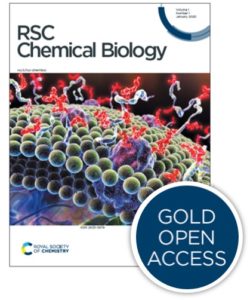
RSC Chemical Biology is an international gold open access journal, publishing exceptionally significant findings in chemical biology.
Sign up now to get updates on all articles as they are published on Twitter and in our e-alerts.
Call for papers – Chemical Proteomics
RSC Chemical Biology is delighted to welcome papers for its latest online themed collection on ‘Chemical Proteomics’, guest edited by Dr Keriann Backus (UCLA, USA) and Dr Stephan Hacker (Leiden University, Netherlands).
Scope
RSC Chemical Biology is delighted to welcome submissions on applications of chemoproteomics to study the targets and off-targets of covalent and non-covalent inhibitors, to study the reactivity of amino acids in the proteome, to develop new reactive groups for photocrosslinkers, covalent inhibitors and protein labeling as well as to study post-translational modifications and cofactor binding proteome-wide.
The deadline for submissions is 30 June 2022.
Submit to the collection now!
Promotion of the collection is scheduled for winter 2022, but articles will be published online as soon as they’re accepted.
Authors are welcome to submit original research in the form of a Communication or Full Paper. Articles can be submitted via our website: rsc.li/rsc-chembio. We would be grateful if upon submission you would be able to mention that your manuscript is intended for this themed collection in the “notes to the editor” box.
Please note that before a final decision is made, all submissions are subject to an initial assessment to confirm the manuscript’s suitability for full peer review.
If you have any questions about the journal or the collection, please contact the editorial office via chembio-rsc@rsc.org.
With kind regards,
| Dr Keriann Backus
UCLA, USA |
Dr Stephan Hacker
Leiden University, Netherlands |
Explore all open calls for papers from RSC journals!
About RSC Chemical Biology
Led by Hiroaki Suga (University of Tokyo), RSC Chemical Biology is dedicated to publishing and disseminating the most exceptionally significant, breakthrough findings of interest to the chemical biology community. All submissions are handled by our experienced and internationally recognised Associate Editors. For more information on the journal, please visit the journal homepage.
As a gold open access journal, there are no barriers to accessing content and your research article will reach an international audience. Please note that the article processing charges are waived until mid-2022, so the journal is currently free to publish in.
RSC Chemical Biology is now indexed in the Directory of Open Access Journals (DOAJ), PubMed Central, Scopus and Web of Science: Emerging Sources Citation Index. Find out more about the journal and submit your work at rsc.li/rsc-chembio
Royal Society of Chemistry
RSC Chemical Biology Advisory Board
New additions to the RSC Chemical Biology Advisory Board!
We are delighted to welcome Professors Lei Liu & Guifang Jia, and Dr Chudi Ndubaku to the RSC Chemical Biology Advisory Board! They join 19 other prominent researchers in the chemical biology field.
Explore the current Advisory Board line-up below. For more information on the Editorial Board, visit rsc.li/rsc-chembio.
 |
Dr Chudi Ndubaku, ORIC Pharmaceuticals, USA
Dr Ndubaku is the Vice President for Drug Discovery at ORIC Pharmaceuticals. |
 |
Professor Guifang Jia, Peking University, China
Professor Jia’s research focuses on the functions of RNA modifications in regulation of human diseases and plant development. |
 |
Professor Lei Liu, Tsinghua University, China
Research in the Lei group focuses on chemical protein synthesis and its applications to biomedical studies. |
 |
Professor Paul Dyson, EPFL, Switzerland
The research in Professor Dyson’s lab centres on organometallic chemistry at the interface with medicine, catalysis and material science. |
 |
Professor Luc Brunsveld, TU Eindhoven, Netherlands
Professor Brunsveld’s research interests are focused on chemical biology approaches studying protein-protein interactions, particularly drug discovery and supramolecular signalling systems. |
 |
Professor Peng Chen, Peking University, China
Professor Chen’s research focus is to develop novel technologies for protein manipulation in living cells, including protein-based bioorthoganol chemistry and precise protein engineering. |
 |
Professor Donald Hilvert, ETH Zurich, Switzerland
The group of Professor Hilvert are using chemical biology tools to understand and engineer proteins for various applications. |
 |
Professor May Khanna, University of Arizona, USA
The work of Professor Khanna’s lab looks to combine biochemical and biophysical techniques to target key protein-protein and protein-RNA interactions in neurodegenerative disease. |
 |
Professor Hermen Overkleeft, Leiden University, Netherlands
The research of the Overkleeft lab is characterized by the design, synthesis and application of chemical probes in glycobiology and immunology. |
 |
Professor Giulio Superti-Furga, CeMM, Austria
The Superti-Furga laboratory addresses the mechanisms by which cells respond to challenges that perturb homeostasis, and how homeostasis can subsequently be restored. |
 |
Professor Xiu-Jie Wang, Chinese Academy of Sciences, China
Professor Wang’s research interests include developing computational methods to analyze biological data, identifying new non-coding regulatory RNA genes and studying the functions of non-coding RNAs. |
 |
Professor Christopher Chang, University of California Berkeley, USA
Professor Chang’s research interests include transition metal signaling, activity-based sensing and artificial photosynthesis. |
 |
Professor Russell Cox, Leibniz University Hannover, Germany
The Cox group is interested in understanding and engineering the biosynthesis of natural products by fungi. |
 |
Professor Dorothea Fiedler, FMP Berlin, Germany
The goal of the Fiedler lab is to develop new chemical and biochemical tools that will provide a mechanistic picture of inositol phosphate signaling. |
 |
Professor Christian Hackenberger, FMP Berlin, Germany
The research projects of Professor Hackenberger’s group focus on understanding how nature generates specific biological function in complex cellular environments. |
 |
Professor Maja Köhn, University of Freiburg, Germany
Professor Köhn’s group explores integrative signaling research on phosphatase chemistry and biology. |
 |
Professor Yamuna Krishnan, University of Chicago, USA
Work in Professor Krishnan’s lab aims to build quantitative chemical maps of organelle lumens using the tools of bionanotechnology. |
 |
Professor Elizabeth Nolan, Massachusetts Institute of Technology, USA
Professor Nolan and her team investigate the chemistry and biology of small molecules, peptides, and proteins that participate in the human innate immune response and host/pathogen interaction. |
 |
Professor Jennifer Prescher, University of California Irvine, USA
The research in Professor Prescher’s lab has the aim of crafting novel chemical probes and noninvasive imaging technologies to interrogate cells in their native habitats. |
 |
Professor Christopher Schofield, University of Oxford, UK
Professor Schofield aims to define functions for all human ‘2OG oxygenases’ at biochemical, cellular, and physiological level. |
 |
Professor Pamela Silver, Harvard Medical School, USA
Professor Silver’s research interests include cell programming, therapeutic design, and environment & pathogen sensing. |
 |
Professor Kira Weissman, University of Lorraine, France
Professor Weissman is expert in multiple aspects of the biosynthesis of polyketides and related secondary metabolites. |
1 year of RSC Chemical Biology – the covers
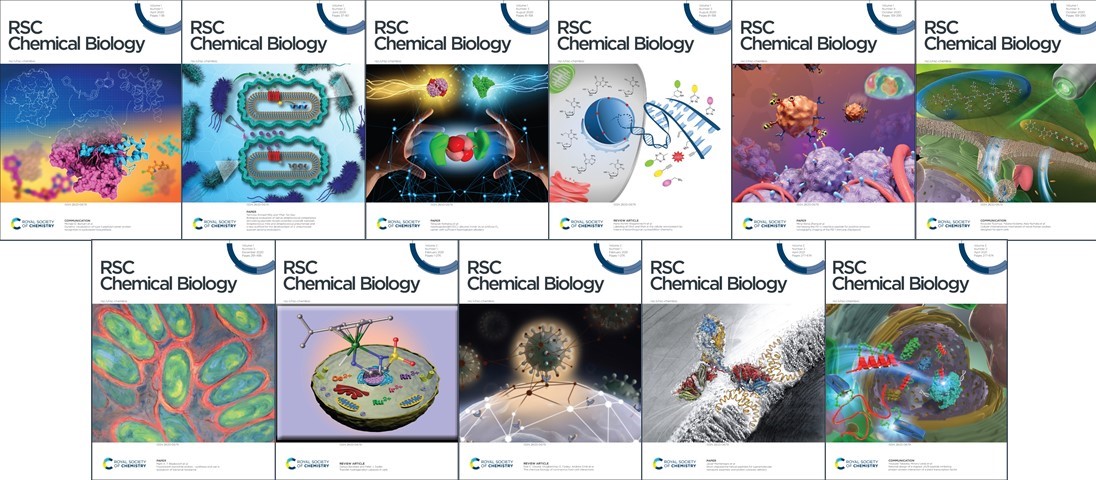
This month we are celebrating our fantastic first year of RSC Chemical Biology! We have seen six issues, containing 56 high quality articles, and two editorials.
We have chosen some of our favourite covers from all the wonderful artwork that has featured on the journal so far. Thank you to all the authors who have provided these amazing artworks!
We invite you to join us on Twitter to vote for your favourite cover of the year from the shortlist below.
Click on each of the images for a close-up look of each cover.
Join us on Twitter to vote for your favourite
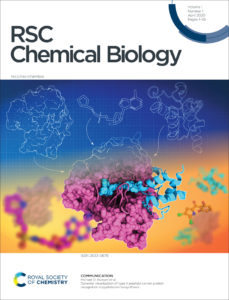 |
A
Vol. 1, Issue 1 Dynamic visualization of type II peptidyl carrier protein recognition in pyoluteorin biosynthesis |
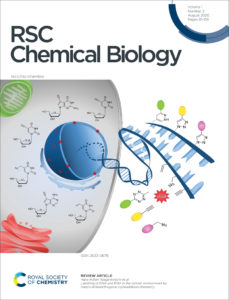 |
B
Vol. 1, Issue 3 Inside cover Labelling of DNA and RNA in the cellular environment by means of bioorthogonal cycloaddition chemistry |
 |
C
Vol. 1, Issue 5 Fluorescent macrolide probes – synthesis and use in evaluation of bacterial resistance |
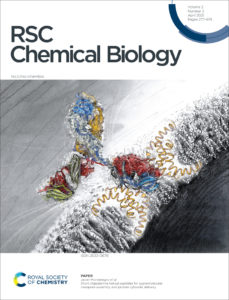 |
D
Vol. 2, Issue 2 Short oligoalanine helical peptides for supramolecular nanopore assembly and protein cytosolic delivery |
The RSC Chemical Biology “Editor’s choice” article collection

The RSC Chemical Biology “Editor’s choice” article collection
The ‘Editor’s choice’ collection for RSC Chemical Biology celebrates the very best work published in the journal to date, including regularly added articles personally chosen by our world-renowned Editorial Board, as well as those highlighted as “HOT” during the peer review process.
November
 |
This month, Associate Editor Gonçalo Bernardes is highlighting two exciting papers involving antibodies.
Professor Bernardes’s choices are detailed below. Access the full collection for free. |
Communication
Leucine-rich alpha-2-glycoprotein 1 (LRG1) as a novel ADC target
Faiza Javaid, Camilla Pilotti, Carlotta Camilli, David Kallenberg, Calise Bahou, Jack Blackburn, James R. Baker, John Greenwood, Stephen E. Moss and Vijay Chudasama
RSC Chem. Biol., 2021, 2, 1206-1220
DOI: 10.1039/D1CB00104C
Paper
Finding and characterizing a catalytic antibody light chain, H34, capable of degrading the PD-1 molecule
Emi Hifumi, Hiroaki Taguchi, Tamami Nonaka, Takunori Harada and Taizo Uda
RSC Chem. Biol., 2021, 2, 220-229
DOI: 10.1039/D0CB00155D
October
 |
After a summer break we were back with Associate Editor Andrea Rentmeister selecting two fantastic articles to highlight.
Professor Rentmeister’s choices are detailed below. Access the full collection for free. |
Review
Cell-free riboswitches
Takeshi Tabuchi and Yohei Yokobayashi
RSC Chem. Biol., 2021, 2, 1430-1440
DOI: 10.1039/D1CB00138H
Professor Rentmeister, “Cell-free systems with the ability to carry out complex functions are an important aspect of synthetic biology. This review focuses on cell-free riboswitches, an overview that has been missing so far. It introduces various prokaryotic and eukaryotic systems and highlights their applications.”
Paper
Click-based amplification: designed to facilitate various target labelling modes with ultralow background amplification
Jinyi Bai, Fusheng Guo, Mengyao Li, Yulong Li and Xiaoguang Lei
RSC Chem. Biol., 2021, 2, 906-916
DOI: 10.1039/D1CB00002K
Professor Rentmeister, “Bai et al present a versatile strategy to the problem of low signal that is often encountered when biological samples are labeled. In their “click-based amplification” a first azide is clicked to a biotin. Instead of using a regular streptavidin (SA), a modified SA with multiple azido-groups then serves as amplifier, allowing to click multiple biotins and to bind multiple reporter SAs. The authors achieved remarkable fluorescence enhancement in cultured cells and tissue.”
July
 |
In July, Editorial Board Member Ali Tavassoli selected two of his favourite articles to highlight.
Professor Tavassoli’s choices are detailed below. Access the full collection for free. |
Review
Proteolysis targeting chimeras (PROTACs) come of age: entering the third decade of targeted protein degradation
Michael J. Bond and Craig M. Crews
RSC Chem. Biol., 2021, 2, 725-742
DOI: 10.1039/ D1CB00011J
Professor Tavassoli, “PROTACs are an exciting new drug modality that hold much promise as potential therapeutics. This timely review provides an excellent summary of this important field and is a great starting point for those interested in learning more about PROTACs.”
Paper
Wheat pathogen Zymoseptoria tritici N-myristoyltransferase inhibitors: on-target antifungal activity and an unusual metabolic defense mechanism
Roman O. Fedoryshchak, Cory A. Ocasio, Benjamin Strutton, Jo Mattocks, Andrew J. Corran and Edward W. Tate
RSC Chem. Biol., 2020, 1, 68-78
DOI: 10.1039/ D0CB00020E
Professor Tavassoli, “This paper is an excellent example of the power and utility of chemical biology and chemical proteomics. The authors identify inhibitors of Z. tritici N-myristoyltransferase, and use these compounds in a chemical proteomics approach to profile the myristolated proteome in Z. tritici. These studies lead to the identification of an unusual mechanism by which the fungus defends itself from NMT inhibitors.”
June
 |
In June, three exciting articles were chosen by Editorial Board Member Jen Heemstra.
Professor Heemstra’s choices are detailed below. Access the full collection for free |
Review
Interfacing non-enzymatic catalysis with living microorganisms
Joanna C. Sadler, Jonathan A. Dennis, Nick W. Johnson and Stephen Wallace
RSC Chem. Biol., 2021, Advance Article
DOI: 10.1039/ D1CB00072A
Professor Heemstra, “Chemical catalysis and biocatalysis each have unique advantages and limitations toward the synthesis of high-value compounds. This review highlights recent progress in biocompatible chemistry, which empowers chemists to interface biotic and abiotic catalysts to develop improved synthetic routes.”
Communication
An activity-based fluorescent sensor for the detection of the phenol sulfotransferase SULT1A1 in living cells
Regina A. Baglia, Kira R. Mills, Koushambi Mitra, Jasmine N. Tutol, Darby Ball, Kierstin M. Page, Jyothi Kallu, Sriharika Gottipolu, Sheena D’Arcy, Steven O. Nielsen and Sheel C. Dodani
RSC Chem. Biol., 2021, 2, 830-834
DOI: 10.1039/ D0CB00231C
Professor Heemstra, “SULT1 enzymes play important roles in biology and this paper reports the first activity-based probe for an enzyme in this class. The naphthol-based sensor functions in vitro and in live cells, providing a useful tool for drug screening and the study of cellular functions of SULT1A1.”
Paper
Synthesis and application of a 19F-labeled fluorescent nucleoside as a dual-mode probe for i-motif DNAs
Wen Ann Wee, Ji Hye Yum, Shingo Hirashima, Hiroshi Sugiyama and Soyoung Park
RSC Chem. Biol., 2021, 2, 876-882
DOI: 10.1039/ D1CB00020A
Professor Heemstra, “Non-canonical DNA structures such as cytosine-rich i-motifs likely have biological importance yet are elusive to study. The authors report a new cytidine analogue that shows increased fluorescence enhancement upon folding and is also compatible with 19F NMR.”
April
 |
In April Associate Editor Roderich Süssmuth selected two high quality articles to add to the collection.
Below are his choices. Access the full collection for free. |
Review
Biosynthesis of alkyne-containing natural products
Xinyang Li, Jian-Ming Lv, Dan Hu and Ikuro Abe
RSC Chem. Biol., 2021, 2, 166-180
DOI: 10.1039/D0CB00190B
Professor Süssmuth, “A review article was long time due, since the alkyne group is of eminent importance in biological chemistry, particularly as a handle for the click reaction. It is interesting to see, that nature also synthesizes this functionality, which is present in various natural products.”
Paper
Intermediary conformations linked to the directionality of the aminoacylation pathway of nonribosomal peptide synthetases
Florian Mayerthaler, Anna-Lena Feldberg, Jonas Alfermann, Xun Sun, Wieland Steinchen, Haw Yang and Henning D. Mootz
RSC Chem. Biol., 2021, Advance Article
DOI: 10.1039/D0CB00220H
Professor Süssmuth, “The work addresses dynamics of non-ribosomal peptide synthetases. The understanding of the gross architecture of the NRPSs from x-ray structures is now followed in this study to understand the dynamics, an aspect of increasing importance.”
March
 |
In March it was the turn of Associate Editor Cai-Guang Yang to highlight three of his favourite articles to date.
Below are his choices. Access the full collection for free. |
Review
Labelling of DNA and RNA in the cellular environment by means of bioorthogonal cycloaddition chemistry
Dorothée Ganz, Dennis Harijan and Hans-Achim Wagenknecht
RSC Chem. Biol., 2020, 1, 86-97
DOI: 10.1039/D0CB00047G
Professor Yang, “This review summarizes DNA and RNA labelling by means of bioorthogonal cycloaddition chemistry in the cellular environment. It also describes current status of orthogonal dual and triple labelling of DNA and RNA in vitro to demonstrate the potential in vivo applications for future.”
Papers
Macrocyclic peptides that inhibit Wnt signalling via interaction with Wnt3a
Manuel E. Otero-Ramirez, Kyoko Matoba, Emiko Mihara, Toby Passioura, Junichi Takagi and Hiroaki Suga
RSC Chem. Biol., 2020, 1, 26-34
DOI: 10.1039/D0CB00016G
Professor Yang, “By applying a unique RaPID display screening technique, this work reports the first instance of de novo macrocyclic peptides acting as direct binders of a highly hydrophobic and not commonly targeted Wnt protein or similar unstable proteins.”
A live-cell assay for the detection of pre-microRNA–protein interactions
Sydney L. Rosenblum, Daniel A. Lorenz and Amanda L. Garner
RSC Chem. Biol., 2021, 2, 241-247
DOI: 10.1039/D0CB00055H
Professor Yang, “This work reports the efforts in the development of a new approach for detection of RNA–protein interactions (RPIs), RNA interaction with Protein- mediated Complementation Assay (RiPCA). RiPCA could serve as a useful tool for detecting RPIs in live cells.”
February
 |
February saw Associate Editor Seung-Bum Park has added his choice to the collection.
Below is Professor Park’s choice. Access the full collection for free. |
Communication
In vivo delivery of a fluorescent FPR2/ALX-targeted probe using focused ultrasound and microbubbles to image activated microglia
Sophie V. Morse, Tamara Boltersdorf, Tiffany G. Chan, Felicity N. E. Gavins, James J. Choi and Nicholas J. Long
RSC Chem. Biol., 2020, 1, 385-389
DOI: 10.1039/D0CB00140F
January
 |
In January we launched the collection with 3 papers chosen by our Editorial Chair, Professor Hiroaki Suga, alongside some of our hottest papers published in 2020.
Below are Professor Suga’s choices. Access the full collection for free. |
Review
The chemical biology of coronavirus host–cell interactions
Suprama Datta, Erik C. Hett, Kalpit A. Vora, Daria J. Hazuda, Rob C. Oslund, Olugbeminiyi O. Fadeyi and Andrew Emili
RSC Chem. Biol., 2021, 2, 30-46
DOI: 10.1039/D0CB00197J
Professor Suga, “This review timely and comprehensively summarizes the biological events linked to the coronavirus outbreak.”
Papers
A thorough analysis and categorization of bacterial interrupted adenylation domains, including previously unidentified families
Taylor A. Lundy, Shogo Mori and Sylvie Garneau-Tsodikova
RSC Chem. Biol., 2020, 1, 233-250
DOI: 10.1039/D0CB00092B
Professor Suga, “The families of interrupted A domains and types of M domains in nonribosomal peptide class of natural products have been categorized. It has illuminated patterns and insights on how to harness them for engineering studies in the future.”
Harnessing the PD-L1 interface peptide for positron emission tomography imaging of the PD-1 immune checkpoint
Kuan Hu, Lin Xie, Masayuki Hanyu, Yiding Zhang, Lingyun Li, Xiaohui Ma, Kotaro Nagatsu, Hisashi Suzuki, Weizhi Wang and Ming-Rong Zhang
RSC Chem. Biol., 2020, 1, 214-224
DOI: 10.1039/D0CB00070A
Professor Suga, “Authors of this paper have developed an impressive PET imaging tool for the most famous immune check point mediated by the PD-1 and PD-L1 interaction, demonstrating not only cell culture and ex vivo detection but also in vivo detection in mice.”
We hope you enjoy reading these articles!
DECHEMA Advances in Chemical Biology Conference
DECHEMA Advances in Chemical Biology conference: Online, 26-28 January 2021
This upcoming conference boasts an innovative and interactive programme of events: RSC Chemical Biology welcomes you to join.
From expert talks and a virtual exhibition, to lectures by young researchers and ePoster presentations, this promises to be a diverse and inspiring conference. Hot topics will include nucleic acids and proteins, peptides and carbohydrates, targeted synthesis concepts and phenotypic screening. For more information, please visit the conference site.
RSC Chemical Biology is delighted to be sponsoring this event as a media partner and invites you to register here now, and check out our virtual booth and join our Meet the Editor Event.
Looking forward to seeing you there,
RSC Chemical Biology Team



